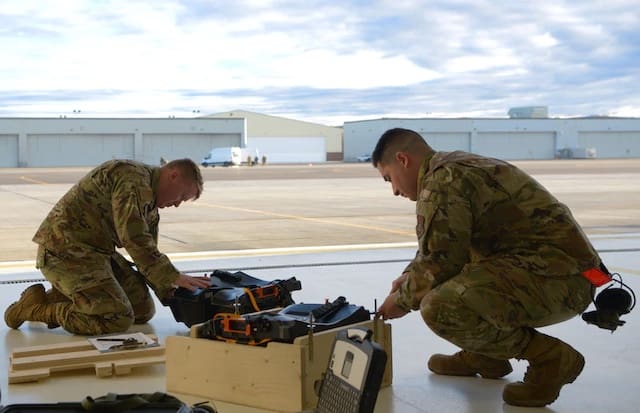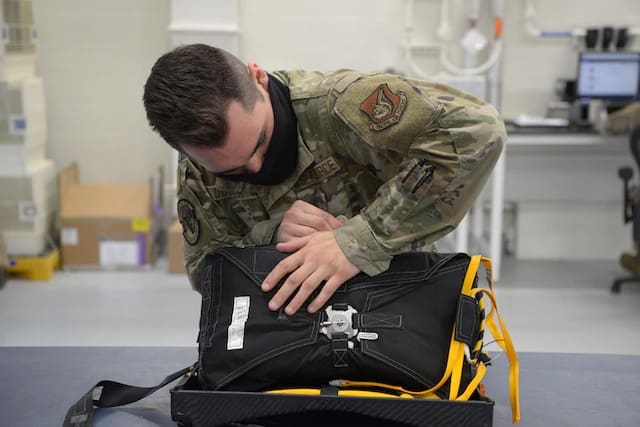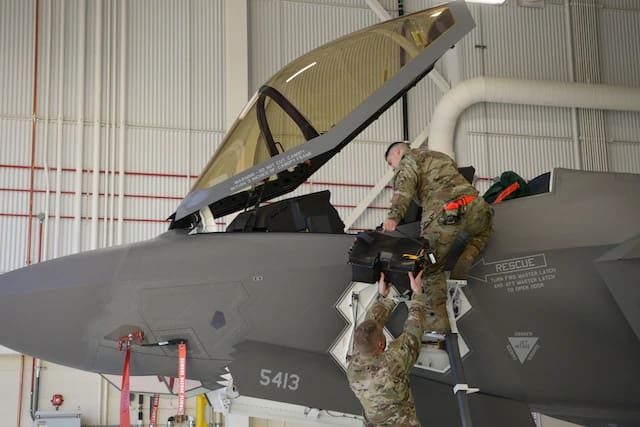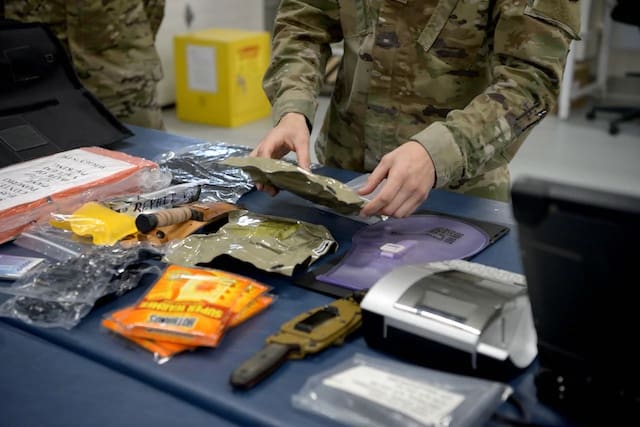EIELSON AIR FORCE BASE, Alaska — In November of 2019, Airmen from the 354th Fighter Wing developed a new arctic survival kit for the F-35A Lightning II. Now, 11 months later, the first kits are being installed in Eielson’s F-35A fleet.

Eielson’s F-35As are the first of the Air Force’s fleet to be stationed in an arctic climate, which drove the need for a new survival kit. After months of research, development and testing, the design was sent to the 354th Operations Group commander for approval. In April the kit was given the “green light” and aircrew flight equipment Airmen got busy building them for the approaching winter.
“Due to the smaller size of the seat we are limited on how many items we can pack in here,” said U.S. Air Force Staff Sgt. Ross Dugger, a 354th Operations Support Squadron AFE craftsman. “Over the years, we’ve worked with [survival, evasion, resistance and escape specialists] to develop this kit and decided what is the most essential equipment needed to survive.”

Airmen from AFE are responsible for packing the kit to fit a specific size in the F-35A before it is ready to go into the jet. The kit consists of survival tools and equipment to help pilots in case of an emergency ejection to include a knife for gathering food, a poncho to stay dry, and flares to signal rescue teams.
“It’s been a learning curve, with the seats being so new they are not as easy to pack,” Dugger said. “With time we will become more efficient and continue to ensure our pilots’ safety.”

After the kit has been packed and fitted to the seat, Airmen assigned to the 354th Maintenance Squadron Aircrew Egress Flight bring the kit to the jet and carefully swap the summer kit with the arctic kit. While doing this, Egress also inspects the seat for discrepancies to ensure the pilot will be safe if they eject.
“We are starting from the ground up, setting up systems and learning as we go,” said Staff Sgt. Victor Benitez, a 354th MXS Aircrew Egress specialist. “There’s a lot of components and sometimes it can take a long time to put just one bolt in, but it has to be done so that everything works 100 percent of the time.”

The new arctic seat kits will be installed on all of Eielson’s F-35A fleet and could potentially be used by some partner nations who have F-35s in similar climates.
“Hopefully they never have to use these items but I take a lot of pride in my work, which could potentially save a pilot’s life,” Dugger said.
By Senior Airman Beaux Hebert, 354th Fighter Wing Public Affairs


I recognize the K-bar, but what’s the other knife?
Actually, that’s not a Ka Bar. That’s an Air Force survival knife. It’s been made by a few different manufacturers. Currently OKC, but definitely not a Ka Bar.
first knife its a Ontario RAT 3 or RC4 Esee
I’m pretty sure it’s the RC4, the sheath which I think is stock matches this much more than the rat 3.
The rat 3 stock sheath doesn’t look anything like that
I find it strange to have Hot Hands as part of the kit. They don’t last long and that space could be used for more calories or weather protection. I’ve been training in the artic for some time and I have never used those things because they are just not effective. for long term sustainment. Its a comfort item if you’re out in the cold for a few hours. Not days or possibly weeks.
They don’t plan on being out there long term. Just long enough for SAR to come scoop them up.
Plus – gloves worn in the cockpit don’t provide a significant level of insulation. Combine that with airspeed and air temp during a possible ejection, and one might end up with significant dexterity issues in the hands… which makes everything (radio, knife/axe, pistol…) next to impossible.
The heat packs are there to get the fingers to work again.
Those are the superwarmer body warmers, they’re 18hr and pretty big. Good stuff, ready heat blankets might be a bit better in some ways worse in others.
Shoot, a fella could have a pretty nice weekend in Vegas with all that.
Two similar-sized knives? I believe in redundancy but that seems an odd choice for such limited space. Is the USAF survival knife still on the vest for an F-35 pilot? It would be interesting to see the whole packing list and rationale.
If there is no vacuum packed sleeping bag, he better wrap up in that chute and get a fire going ASAP. I’d like to see some form of massively effective fire-starter, which works in soaking wet conditions – if not chemical based, perhaps new-tech batteries might make an electric lighter possible?
Let’s not forget gents. The Air Force is run by pilots. The idea is that any ejections will be swept up ASAP. These are comfort items if anything while the PJs are looking for you.
The knife in the lower right of the photo is one of our knives, likely an ESEE or RC 4. It is not made by Ontario Knife Co. The knife in the upper left of the photo with the leather washer handle is the old ‘bolt knife’ made by Car Bar or Ontario Knife. It frequently failed due to the tang literally being a skinny bolt inning the entire length of the handle.
Mike Perrin
I hate bolt knives. Absolute junk. They should have replaced it years ago.
All,
Back in the day, the knife on the left was usually called a “pilots survival knife” and dates back to the 50s. It was standard issue for Army Aviators for decades as well as pilots of other services. Apparently it still is. Camillus made them as well IIRC.
The 82nd Airborne Division’s Jumpmaster School used to issue them to graduates at least into the 1990s. I understand that the JM school at Benning did as well. To be fair, there were not that many fixed blade knives in the supply system. The USMC Kabar was popular for individual purchase, but was not available in the Army system.
I broke many a rat tail kabar throwing them at trees. When I had enough money I bought a Randall.
TLB
In the Air Force, we call them Bolt Knives because the butt is a hexagon shape like a bolt head.
This^